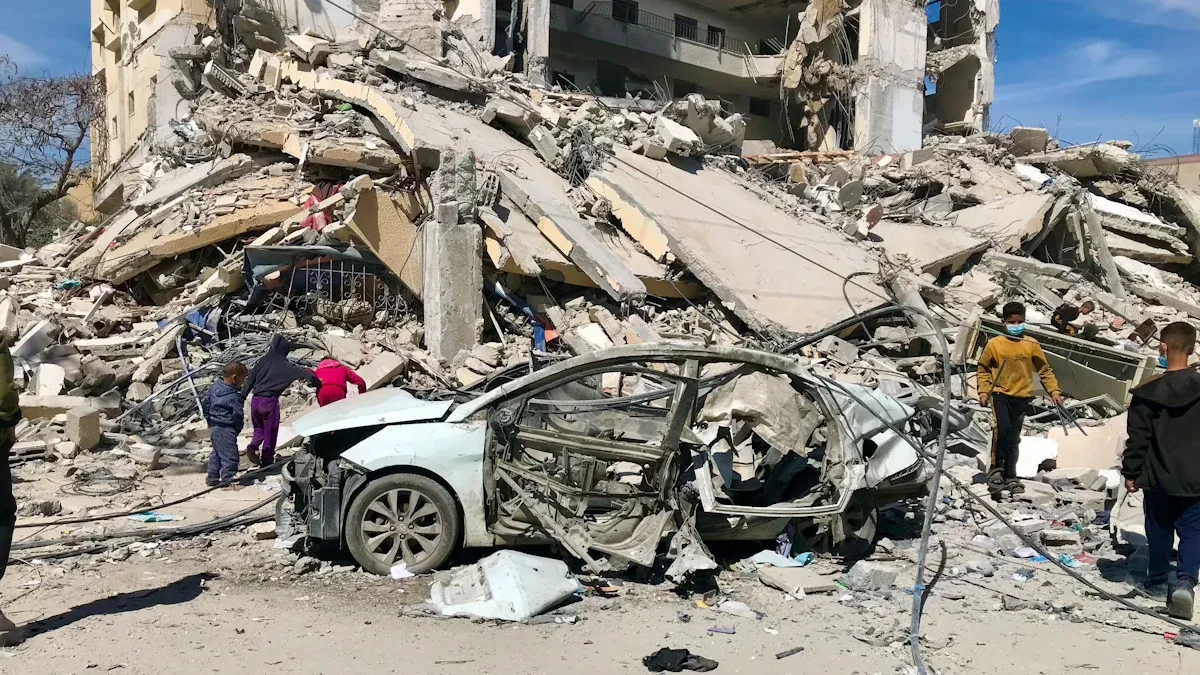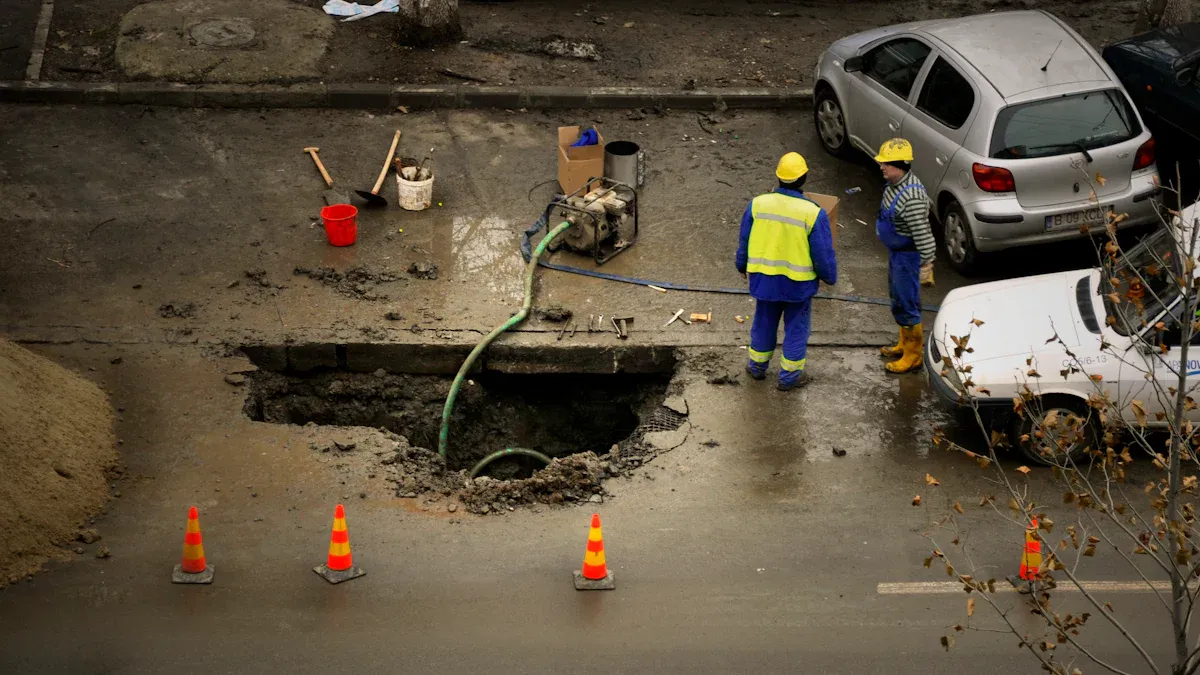
You often see construction vehicles involved in accidents in cities. Heavy equipment drives through busy streets and work zones, which contribute to about 2% of all road deaths. These work zones also lead to many serious injuries. In places like Florida, roadwork occurs year-round, resulting in heavy traffic and an increased likelihood of accidents. Speeding is a significant issue, and fines for speeding continue to rise. Speed limiter devices can help control speed, thereby reducing the risk of construction vehicles accidents. They also assist in keeping your fleet safe and compliant with regulations.
Key Takeaways
- Construction vehicles cause about 2% of road deaths. This is mostly because they are big and move fast. Knowing what these vehicles can and cannot do helps stop accidents.
- Speeding is a big reason for crashes in work zones. Always obey speed limits. Slow down when you see construction to stay safe.
- Drivers who use phones or eat are more likely to crash. Pay attention to the road. Do not let anything distract you while driving.
- Speed limiter devices can lower the number of crashes. They also help save fuel. These devices keep trucks at safe speeds.
- Checking vehicles often and teaching drivers safety rules is important. These steps help follow the law and keep workers and people safe.
Urban Challenges for Construction Vehicles
Size and Maneuverability
Driving construction vehicles in cities is hard. These trucks are much bigger and heavier than normal cars. A dump truck with a full load can weigh over 30 tons. That is almost 20 times heavier than a family car.
- Big trucks need more room to turn and stop.
- They take longer to stop, so reacting fast is tough.
- Their high centers of gravity make turning tricky in small spaces.
- Blind spots can hide smaller cars, which makes accidents more likely when you change lanes or merge.
- If you slow down in work zones and do not notice in time, you might get hit from behind.
Dense Traffic and Limited Space
Cities have lots of cars and little space to drive. You must think about every move to avoid problems.
- You drive with many cars, buses, and people walking.
- You stop and go a lot at busy intersections.
- Parked cars can block your view and make driving dangerous.
- Delivery workers and people may walk into the street suddenly.
- Turning or merging across many lanes is hard and risky.
Tip: Always look in your mirrors and check blind spots before you turn or change lanes. Staying alert helps you avoid surprises.
Road Conditions and Hazards
City roads have many dangers for construction vehicles. You see work zones, bumpy roads, and quick changes in traffic.
- Driving through work zones means you face sudden changes in the road.
- Big equipment and narrow lanes make driving harder.
- Bad roads with potholes can make you lose control.
- Fast changes in traffic rules or speed limits can confuse drivers.
| Hazard Type | Description |
| Work Zone Hazards | Highway workers, traffic cones, road closure signs, construction materials |
| Urban Driving Challenges | Sudden changes in road width, uneven surfaces, frequent intersections, and pedestrians |
You need to stay alert and adjust quickly to keep everyone safe.
Causes of Construction Vehicles Accidents

Speeding and Reckless Driving
Driving too fast in cities is very risky. Speeding is a main cause of construction vehicles accidents. When you go over the speed limit, you have less time to react. In busy areas, cars, bikes, and people can appear quickly. Large trucks cannot stop fast when going too fast. This can cause more crashes and injuries.
- Speeding makes stopping hard in heavy traffic.
- Fast driving means you control the truck less.
- Safety barriers do not work as well if you drive too fast.
Reckless driving, like weaving or breaking rules, is also dangerous. Rushing or taking risks puts everyone in danger. Studies show speeding and reckless driving are top reasons for accidents in work zones.
Note: Always follow speed limits and slow down in work zones. Safe driving helps stop construction vehicles accidents.
Driver Distraction and Negligence
Getting distracted is another big cause of construction vehicles accidents. Looking at your phone, eating, or talking makes you lose focus. Even a short distraction can cause a crash. For example, reading a text at 55 MPH means your truck goes far before you look up.
Common distractions are:
- Using a cell phone
- Eating or drinking
- Adjusting GPS devices
- Grooming or fixing your hair
- Talking to people in the truck
Negligence, like ignoring safety rules or driving tired, is also risky. Long hours and poor sleep make it hard to stay alert. Not paying attention means you might miss signs or traffic changes.
Tip: Put your phone away and watch the road. Take breaks if you feel sleepy. Careful driving lowers construction vehicles accidents.
Poor Visibility and Signage
Bad visibility and poor signs often cause construction vehicles accidents. If you cannot see well, you may miss dangers or road changes. Dim lights, fog, rain, or darkness make it hard to see cars or people. Large trucks have big blind spots, so you must be extra careful.
Bad signage is also a problem. Small or hidden signs can confuse drivers. If you miss a warning sign, you might not slow down or change lanes in time. Experts say missing or unclear signs raise the chance of crashes, especially at night or in bad weather.
- Poor lighting makes it hard to see road changes.
- Hidden or missing signs mean you are not ready for stops or turns.
- Confusing roads make things more dangerous.
Alert: Always look for signs and watch for road changes. Good visibility and clear signs help stop construction vehicles accidents.
Speed Violations and Penalties
Common Speed-Related Offenses
Many construction vehicles break speed rules in cities. Speeding and aggressive driving cause many work zone crashes. Driving too fast in a construction zone can get you a big fine. You might also face other serious punishments. Here are some common speed-related offenses:
- Speeding in construction zones
- Aggressive driving, like weaving or tailgating
- Not following posted speed limits near work areas
If you get caught speeding for the first time, you may pay $300. If you break the rule again, you could pay up to $1,000. These punishments show why it is important to follow speed rules and avoid construction vehicles accidents.
Tip: Always look for speed limit signs in work zones. Slowing down keeps everyone safe.
Legal and Financial Consequences
Breaking speed rules brings tough legal and money problems. You may have to pay higher fines and get points on your driving record. Your insurance can cost more. If you keep breaking rules, you might lose your license. The table below shows what can happen if you break speed rules:
| Violation Type | Penalty Description | Points on Record | Potential Long-term Consequences |
| Speeding in Construction Zone | Fines can be much higher than normal speeding fines, sometimes double or triple. | Yes | Higher insurance costs, maybe license suspension. |
| Excessive Speeding or Reckless Driving | Very serious punishments, including losing your license. | Yes | Must take driving classes, maybe lose license forever. |
| Causing an Accident in a Construction Zone | You could be sued for damages, or even face jail. | Yes | Prison time, permanent criminal record. |
In California, fines for speeding in a construction zone can be $525 for going 16-25 mph over the limit. If you go 26 mph or more over, the fine can be $648. Each time you break the rule, you get points on your DMV record. This can make your insurance cost more.
Impact on Companies and Drivers
Speed rule violations hurt both drivers and companies. You may have to pay more because of delays, higher insurance, and legal fees. Companies lose money when projects are late or when they pay contract penalties. Here are some ways speed rule violations hurt your business:
- More costs from longer equipment rentals and extra labor
- Lost money because projects are late
- Legal trouble from lawsuits or fights over contracts
- Rushing can cause mistakes, so workers must redo the job.
- Fixing mistakes makes projects take longer and can mean more penalties.
When projects are late, companies may have to pay more for lawyers or settlements. These problems make it harder to finish projects on time and cost more money. Following speed rules helps stop construction vehicles accidents and protects your business.
Solutions: Speed Limiter Devices and Compliance

How Speed Limiters Work
Speed limiter devices, also called vehicle governors, help control truck speed. These devices use smart technology to keep trucks from going too fast. When you put a speed limiter construction truck system in your trucks, drivers cannot go over a set speed. This helps stop accidents and keeps your fleet following city rules.
Here is how these devices work inside your trucks:
| Mechanism | Description |
| Engine Control Unit (ECU) | Controls fuel flow and ignition timing to limit speed smoothly. |
| Brake Integration | Engages braking system to slow the vehicle down when speed exceeds the limit. |
| Throttle Control | Prevents throttle from opening beyond a set limit to avoid sudden acceleration. |
| Transmission Control | Forces downshifting to maintain low RPM and speed. |
| Wheel Speed Sensors | Provides real-time speed data for precise control of the speed limiter. |
With HBOIOT’s fleet speed-limiting solutions, you gain real-time feedback and automated speed control, helping protect drivers on the road while preventing costly fines and regulatory issues.
Benefits for Safety and Fuel Efficiency
You get many good things when you use speed limiter construction trucks. The biggest benefit is safety. Lower speeds mean fewer accidents and less serious crashes. Studies show trucks with speed limiters crash much less. The U.S. Department of Transportation says setting a truck’s top speed at 65 mph could save over 200 lives and stop almost 5,000 injuries each year.
Drivers can react better to sudden changes in traffic at lower speeds. They have more time to stop or turn if something happens. This lowers the chance of bad accidents and saves lives.
| Safety Benefit | Description |
| Reduce accidents | High speeds increase the chance and severity of crashes. Speed limiters help lower this risk. |
| Improve Reaction Time | Lower speeds give drivers more time to react to road changes or obstacles. |
| Mitigate Fatalities | Slower speeds mean fewer deaths if a crash does happen. |
You also save money on fuel. Speed limiters help trucks use less fuel by stopping fast starts and hard stops. You can save up to 5% on fuel in city driving. For a big fleet, this means lots of savings every year. The Federal Motor Carrier Safety Administration says speed limiters could save $605 million in fuel costs for large vehicles. Driving at steady, moderate speeds makes trucks run better and pollute less.
Here are more ways speed limiters help your business:
- You cut down on aggressive driving, which saves fuel.
- You lower your carbon footprint by using less fuel.
- You avoid fines and penalties for speeding.
- You keep insurance costs down by having fewer accidents.
Adoption by Construction Fleets
Many construction companies, logistics providers, and city sanitation fleets now use fleet speed compliance devices. City driving is hard because of changing rules, not enough drivers, and tight project deadlines. Speed limiter construction trucks help you handle these problems by making your fleet safer and more efficient.
When you add speed limiters to your trucks, you:
- Make sure drivers follow speed limits in every city.
- Protect workers and the public from accidents.
- Cut down on fuel theft and waste.
- Reduce downtime from accidents and repairs.
- Show clients and partners that you care about safety and the environment.
Tip: Teach your drivers how speed limiters work. Explain the safety and fuel savings. This helps everyone in your company support the change.
You may need to learn new rules and train your team, but the rewards are worth it. Speed limiter construction trucks and fleet speed compliance devices give you tools to keep your business safe, legal, and successful in busy cities.
Driving construction vehicles in cities is risky. Speeding, bad visibility, and distractions cause accidents and fines. Speed limiter devices help control speed and keep fleets safe. To make things safer, you should:
- Teach drivers and follow safety rules
- Check vehicles often to keep them working well
- Put up signs that are easy to see and change them when needed
- Watch driver speed with special tools
| Strategy | Description |
| Active Compliance Monitoring | Check driver speed and actions often |
| Proactive Safety Measures | Use speed limiters and radar signs |
| Auditing Checklists | Handle safety jobs with simple lists |
Pay attention to new traffic problems and use smart tools to keep your team and others safe.
FAQ
What is a speed limiter device for construction trucks?
A speed limiter device sets a maximum speed for your truck. You cannot drive faster than this limit. This helps you stay safe and follow city speed rules.
Why do construction vehicles get more speeding tickets in cities?
You drive in busy areas with strict speed limits. Large trucks take longer to stop. If you go too fast, you often get caught by cameras or police.
How does a speed limiter help reduce accidents?
A speed limiter keeps your truck from going too fast. You have more time to react to sudden stops or people crossing the street. This lowers accident risks.
Who should use fleet speed compliance devices?
Construction companies, logistics providers, and city sanitation fleets should use these devices. You keep your drivers safe and avoid costly fines.
Can speed limiters save fuel for my fleet?
Yes! Speed limiters help you drive at steady speeds. You use less fuel and save money. Your trucks also last longer with less wear and tear.
